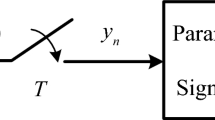Abstract
Finite rate of innovation sampling is a new signal sparse sampling method based on signal information freedom, which can considerably reduce the amount of sampling data. However, the researches on hardware circuit direct implementation of the method are at an initial stage. Therefore, a novel hardware circuit implementation method based on an exponential reproducing kernel (ERK) was developed with an improved ERK sparse sampling theoretical framework, which comprised an analog rational kernel (ARK) and digital rational kernel (DRK). The parameter constraint conditions and selection method for the improved ERK were analyzed. The performance of the ARK hardware circuit and the DRK algorithm were also examined. The designed sparse sampling system was applied to a pipeline flaw ultrasonic inspection by using the sparse sampling data of the ultrasonic signal obtained directly. The experimental results revealed that the proposed method could directly obtain the signal sparse sampling data and accurately reconstruct the initial signal parameters by using a spectrum estimation algorithm. Moreover, the signal sampling rate and the amount of sampling data were reduced considerably.












Similar content being viewed by others
References
L. Baboulaz, P.L. Dragotti, Exact feature extraction using finite rate of innovation principles with an application to image super-resolution. IEEE Trans. Image Process. 18(2), 281–298 (2009)
S. Chen, L. Wang, G. Chen, Data-aided timing synchronization for FM-DCSK UWB communication systems. IEEE Trans. Ind. Electron. 57(5), 1538–1545 (2010)
S. Deslauriers-Gauthier, P. Marziliano, Sampling signals with a finite rate of innovation on the sphere. IEEE Trans. Signal Process. 61(18), 4552–4561 (2013)
P.L. Dragotti, M. Vetterli, T. Blu, Sampling moments and reconstructing signals of finite rate of innovation: Shannon meets strange-fix. IEEE Trans. Signal Process. 55(5), 1741–1757 (2007)
N. Gehrig, P. L. Dragotti, Distributed sampling and compression of scenes with finite rate of innovation in camera sensor networks, in Data Compression Conference (2006), pp. 83–92
G.H. Golub, P. Milanfar, J. Varah, A stable numerical method for inverting shape from moments. Soc. Ind. Appl. Math. 21(4), 1222–1243 (1999)
Z. Jiang, Research on Hardware Implementation Method of Ultrasonic Signal Sparse Sampling Based on Finite Rate of Innovation (Jiangsu University, Zhenjiang, 2017). (in Chinese)
J. Lin, F. Gao, Z. Luo, L. Zeng, High-resolution Lamb wave inspection in viscoelastic composite laminates. IEEE Trans. Ind. Electron. 63(11), 6989–6998 (2016)
X. Li, A. Rueetschi, Y.C. Eldar, A scaglione GPS signal acquisition via compressive multichannel sampling. Phys. Commun. 5(2), 173–184 (2012)
I. Markovsky, Structured low-rank approximation and its applications. Automatica 44(4), 891–909 (2008)
G. C. F. M. R de Prony, Essai expérimental et analytique: sur les lois dela dilatabilitédes fluides élastiques et sur celles de la force expansive de la vapeur de l’eau et de la vapeur de l’alcool à différentes températures. Journal de l’école polytechnique (1975)
S.P. Song, Z. Jiang, Quadrature demodulation-based circuit implementation of pulse stream for ultrasonic signal FRI sparse sampling. Meas. Sci. Technol. 28(3), 035005 (2017)
Y. Shi, L. Zeng, Signal Reconstruction algorithm of finite rate of innovation with matrix pencil and principal component analysis. IEICE Trans. Fundam. Electron. Commun. Comput. Sci. 100, 761–768 (2017)
R. Tur, Y.C. Eldar, Z. Friedman, Innovation rate sampling of pulse streams with application to ultrasound imaging. IEEE Trans. Signal Process. 59(4), 1827–1842 (2011)
J.A. Urigüen, T. Blu, P.L. Dragotti, FRI sampling with arbitrary kernels. IEEE Trans. Signal Process. 61(21), 5310–5323 (2013)
M. Unser, Cardinal exponential splines: part II—think analog act digital. IEEE Trans. Signal Process. 53(4), 1439–1449 (2005)
M. Unser, T. Blu, Cardinal exponential splines: part I—theory and filtering algorithms. IEEE Trans. Signal Process. 53(4), 1425–1438 (2005)
M. Vetterli, P. Marziliano, T. Blu, Sampling signals with finite rate of innovation. IEEE Trans. Signal Process. 50(6), 1417–1428 (2002)
Y.J. Wang, M. Li, G.F. Liu, Sampling complex pulse streams with finite rate of innovation methods. J. Electron. Inf. Technol. 35(7), 1606–1611 (2013). (in Chinese)
L. Xu, F. Ding, Recursive least squares and multi-innovation stochastic gradient parameter estimation methods for signal modeling. Circuits Syst. Signal Process. 36(4), 1735–1753 (2017)
Acknowledgements
This project was supported by the National Natural Science Foundation of China (Grant No. 51375217).
Author information
Authors and Affiliations
Corresponding author
Additional information
Publisher’s Note
Springer Nature remains neutral with regard to jurisdictional claims in published maps and institutional affiliations.
Rights and permissions
About this article
Cite this article
Song, S., Yu, J. & Shen, J. Novel Circuit Implementation Method for Pulse Signal Finite Rate of Innovation Sparse Sampling Based on an Improved Exponential Reproducing Kernel. Circuits Syst Signal Process 38, 4683–4699 (2019). https://doi.org/10.1007/s00034-019-01076-3
Received:
Revised:
Accepted:
Published:
Issue Date:
DOI: https://doi.org/10.1007/s00034-019-01076-3




